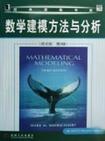数学建模方法与分析
出版时间:2009-1 出版社:机械工业 作者:米尔斯切特 页数:335
Tag标签:无
前言
Mathematical modeling is the link between mathematics and the rest of the world. You ask a question. You think a bit, and then you refine the question, phrasing it in precise mathematical terms. Once the question becomes a mathematics question, you use mathematics to find an answer. Then finally (and this is the part that too many people forget), you have to reverse the process, translating the mathematical solution back into a comprehensible, no-nonsense answer to the original question. Some people are fluent in English, and some people are fluent in calculus. We have plenty of each. We need more people who are fluent in both languages and are willing and able to translate. These are the people who will be influential in solving the problems of the future.This text, which is intended to serve as a general introduction to the area of mathematical modeling, is aimed at advanced undergraduate or beginning graduate students in mathematics and closely related fields. Formal prerequisites consist of the usual freshman-sophomore sequence in mathematics, including one-variable calculus, multivariable calculus, linear algebra, and differential equations. Prior exposure to computing and probability and statistics is useful, but is not required.
内容概要
本书提出了一种通用的数学建模方法——五步方法。帮助读者迅速掌握数学建模的真谛。作者以引人入胜的方式描述了数学模型的3个主要领域:最优化、动力系统和随机过程。本书以实用的方法解决各式各样的现实问题,包括空间飞船的对接、传染病的增长率和野生生物的管理等。此外,本书根据需要详细介绍了解决问题所需要的数学知识。 本版新增内容: 增加了关于时间序列分析和扩散模型的新节。 关注国际性问题,如经济预测、人口控制、蓄水池。此外,更新了最优化问题。
作者简介
Mark M.Meerschaert美国密歇根州立大学概率统计系主任,内华达大学物理系教授。他曾在密歇根大学,英格兰学院、新西兰达尼丁Otago大学执教,讲授过数学建模、概率、统计学、运筹学、偏微分方程、地下水及地表水水文学与统计物理学课程。他当前的研究方向包括无限方差概率
书籍目录
PrefaceⅠ OPTIMIZATION MODELS 1 ONE VARIABLE OPTIMIZATION 1.1 The Five-Step Method 1.2 Sensitivity Analysis 1.3 Sensitivity and Robustness 1.4 Exercises 2 MULTIVARIABLE OPTIMIZATION 2.1 Unconstrained Optimization 2.2 Lagrange Multipliers 2.3 Sensitivity Analysis and Shadow Prices 2.4 Exercises 3 COMPUTATIONAL METHODS FOR OPTIMIZATION 3.1 One Variable Optimization 3.2 Multivariable Optimization 3.3 Linear Programming 3.4 Discrete Optimization 3.5 ExercisesⅡ DYNAMIC MODELS 4 INTRODUCTION TO DYNAMIC MODELS 4.1 Steady State Analysis 4.2 Dynamical Systems 4.3 Discrete Time Dynamical Systems 4.4 Exercises 5 ANALYSIS OF DYNAMIC MODELS 5.1 Eigenvalue Methods 5.2 Eigenvalue Methods for Discrete Systems 5.3 Phase Portraits 5.4 Exercises 6 SIMULATION OF DYNAMIC MODELS 6.1 Introduction to Simulation 6.2 Continuous-Time Models 6.3 The Euler Method 6.4 Chaos and Fractais 6.5 ExercisesⅢ PROBABILITY MODELS 7 INTRODUCTION TO PROBABILITY MODELS 7.1 Discrete Probability Models 7.2 Continuous Probability Models 7.3 Introduction to Statistics 7.4 Diffusion 7.5 Exercises 8 STOCHASTIC MODELS 8.1 Markov Chains 8.2 Markov Processes 8.3 Linear Regression 8.4 Time Series 8.5 Exercises 9 SIMULATION OF PROBABILITY MODELS 9.1 Monte Carlo Simulation 9.2 The MarkovProperty 9.3 Analytic Simulation 9.4 ExercisesAfterwordIndex
章节摘录
Problems in optimization are the most common applications of mathematics. Whatever the activity in which we are engaged, we want to maximize the good that we do and minimize the unfortunate consequences or costs. Business managers attempt to control variables in order to maximize profit or to achieve a desired goal for production and delivery at a minimum cost. Managers of renewable resources such as fisheries and forests try to control harvest rates in order to maximize long-term yield. Government agencies set standards to minimize the environmental costs of producing consumer goods. Computer system managers try to maximize throughput and minimize delays. Farmers space their plantings to maximize yield. Physicians regulate medications to minimize harmful side effects. What all of these applications and many more have in common is a particular mathematical structure. One or more variables can be controlled to produce the best outcome in some other variable, subject in most cases to a variety of practical constraints on the control variables. Optimization models are designed to determine the values of the control variables which lead to the optimal outcome, given the constraints of the problem.We begin our discussion of optimization models at a place where most students will already have some practical experience. One-variable optimization problems, sometimes called maximum-minimum problems, are typically discussed in first semester calculus. A wide variety of practical applications can be handled using just these techniques. The purpose of this chapter, aside from a review of these basic techniques, is to introduce the fundamentals of mathematical modeling in a familiar setting.
媒体关注与评论
“这是一本很好的教学建模教科书,其中的数学知识非常有用,符合本科生数学建模课程的教学要求。” ——Iohn E Doner.加州大学圣芭芭拉分校数学系
编辑推荐
《数学建模方法与分析(英文版·第3版)》为经典原版书库丛书之一,由机械工业出版社出版。
图书封面
图书标签Tags
无
评论、评分、阅读与下载
用户评论 (总计13条)
- 我和我队友都买了这书。这书的内容特点是:语言很流畅,对于建模论文(美赛)写作很有指导意义。
此外介绍的五步建模法也是挺有借鉴意义的。
总体来说给好评! - 沙发···对于想学习算法的,本书作为算法数学基础教材很不错
- 很好的书,很详细,看得出编者很用心,适合刚刚开始学的同学
- 参加美国赛用得着
- 这本书不错,很有指导意义!
- 看了受益匪浅 站的角度很高!
- 内容很全面 适合初学者
- 根本不是原版书,只是影印过来的。纸质很薄,不耐翻。内容很不错,但实在有些贵。
- 还没有看完。这本书写得很形象和详细,作者提出的“五步法”也很实用,并结合了计算机技术辅助解题,很不错!
- 书,可以,美中不足的是没得光盘。。。
- 很好的一本书,对建模的过程分析的很清楚。
- 很专业的书,一般还真不好找,
- 经典专业书籍,值得好好看。
